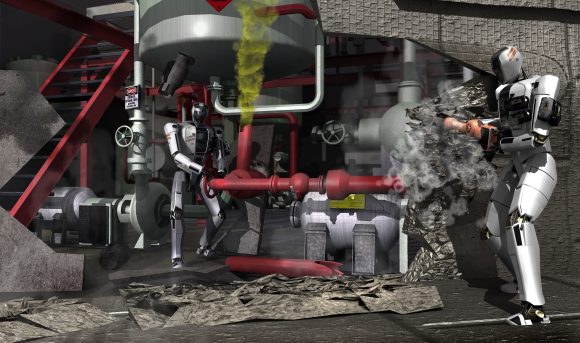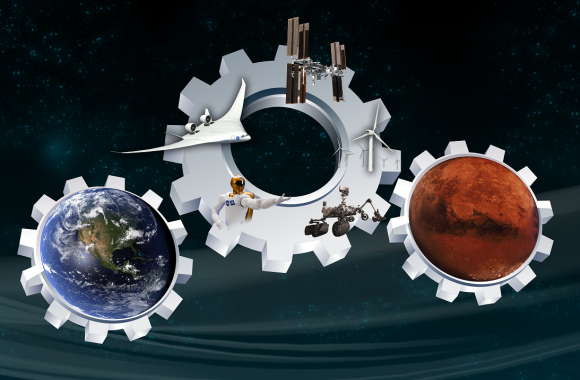For over a decade, robots have been exploring Mars in advance of the crewed missions that are being planned for the coming decades. And when it comes time for astronauts to set foot on the Red Planet, they will be looking for robots to help them with some of the legwork. After all, exploring Mars is tough, laborious, and dangerous work, so some robotic assistance will probably be necessary.
For this reason, back in November of 2015, NASA gave the Massachusetts Institute of Technology one of their R5 “Valkyrie” humanoid robots. Since that time, MIT’s Computer Science and Artificial Intelligence Laboratory (CSAIL) has been developing special algorithms that will allow these robots to help out during future missions to Mars and beyond.
These efforts are being led Professor Russ Tedrake, an electrical engineer and computer programmer who helped program the Atlas robot to take part in the 2015 DARPA Robotics Challenge. Together with members of an advanced independent research group – known as the Super Undergraduate Research Opportunities Program (SuperUROP) – he is getting this R5 robot ready for NASA’s Space Robotics Challenge.

As part of NASA’s Centennial Challenges Program, and with a prize purse of $1 million, this competition aims to push the boundaries of what robots are capable of in the realm of space exploration. In addition to MIT, Northeastern University and the University of Edinburgh have been tasked with programming an R5 to complete tasks normally handled by astronauts.
Ultimately, the robots will be tested in a simulated environment and judged based on their ability to complete three tasks. These include aligning a communications array, repairing a broken solar array, and identifying and repairing a habitat leak. There will also be a qualifying round where teams will be tasked with demonstrating autonomous tracking abilities (which will have to be completed in order to move towards the main round).
Naturally, this presents quite a few challenges. NASA designed the R5 robot to be capable of performing human tasks and move like a human being as much as possible, which necessitated a body with 28 torque-controlled joints. However, getting those joints to work together to perform mission-related work and operate independently is a bit of a challenge.
In short, the robot is not like other robotic missions – such as the Opportunity or Curiosity rovers. Instead of having a human being pushing levers to get them to move about and collect samples, the R5 will be tasked with things like opening airlock hatches, attaching and removing power cables, repairing equipment, and retrieving samples all on its own. And of course, if it takes a spill and falls down, it will have to be able to get up on its own.

With the help of the special algorithms being generated by Tedrake and his colleagues – as well as other teams competing in this challenge – robots could play an important role in future missions. This could involve robots selecting landing sites for astronaut crews, setting up habitats in advance of crews arriving, and even conducting preliminary research on celestial bodies.
In addition, robots could take the place of crews on long-distance missions (such as Europa). Instead of sending a crew that would require months of food and supplies, a robot crew could be dispatched to the Jovian moon to collect ice samples, explore the surface, and interface with drones being sent to explore the interior ocean. And if the mission failed, there would be no grieving families (just grieving robotics teams).
And now to address the elephant in the room. The idea of sending robot explorers on space missions to help astronauts (or even replace them) is sure to make some people out there nervous. But for those who fear that this might bring one step closer to a robot revolution, rest assured that the machines are nowhere near where they’d need to be to go all “Judgement Day” on us just yet.
Long before they can launch nuclear weapons, pick up laser guns and stalk us through a post-apocalyptic landscape, or start upgrading themselves to look (and feel) human, robots will first need to master the simple tasks of walking upright and holding a screwdriver.
Still, if any of the robots end up having creepy red visor eyes (or saying things like “by your command”), we might want to consider including the Three Laws of Robotics in their programming. It’s never too soon to make sure they can’t turn on humanity!
Registration for the Space Robotics Challenge opened in August, 2016. The qualifying round, which began in mid-October, will run until mid-December. Finalists of that round will be announced in January, with the final virtual competition taking place in June 2017. The winning team will be awarded $500,000 over a two year period from NASA’s Space Technology Mission Directive.

